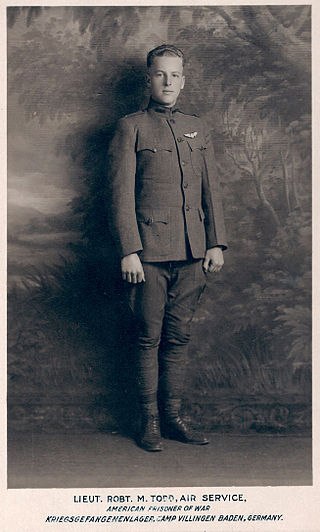
Air Vice Marshal George Roberts Howsam, CB, MC was a Canadian First World War flying ace, officially credited with 13 victories. Serving in the newly formed Royal Canadian Air Force in the inter-war years, Howsam served as the RCAF's Director of Training during World War II.
Lieutenant Harold Byrn Hudson MC was a Canadian First World War flying ace, officially credited with 13 victories. As wingman to William George Barker, he scored a record five victories over observation balloons in a single day.
Captain Hazel LeRoy Wallace DFC was a Canadian First World War flying ace, officially credited with 14 victories. His record shows him to have been a notable team player in squadron tactics.
Lieutenant Harry Neville Compton was a World War I flying ace credited with five aerial victories.
Lieutenant George William Gladstone Gauld was a World War I flying ace credited with five aerial victories.
Lieutenant Harold Arthur Sydney Molyneux was a World War I flying ace credited with five aerial victories. During World War II, he returned to service in the Royal Canadian Air Force.

Lieutenant Orville Alfred Ralston was a World War I flying ace credited with five aerial victories. He returned to service for World War II, only to die in a B-17 crash.
Major Oliver Stewart MC AFC (1896-1976) was a World War I flying ace credited with five aerial victories. Post war, he had a long and distinguished career as a writer.

Lieutenant William Dolley Tipton began his military career as a World War I Sopwith Camel pilot. The U.S. Air Force officially credits him with four aerial victories during the war, although other sources claim he had five, and thus was a flying ace. He was one of the founding officers of what would become the Maryland Air National Guard. As a member of the Maryland National Guard, he was mobilized during World War II. He rose to the rank of colonel during the war. He died on December 12, 1945, in an aircraft accident. Tipton Airport in Anne Arundel County, Maryland, is named in his honor.

Lieutenant Hilbert Leigh Bair began his service career as a World War I flying ace credited with six aerial victories.
Captain Henry Gordon Clappison was a World War I flying ace credited with six aerial victories.

Howard Clayton Knotts was a prominent American aviation lawyer who served in World War I as a flying ace credited with six aerial victories.
Captain Ronald Sykes (1899-1977) was a World War I flying ace credited with six aerial victories.
Lieutenant Cecil Robert Thompson was a South African World War I flying ace credited with six aerial victories.
Lieutenant Archibald Buchanan was a World War I flying ace credited with seven aerial victories.
Captain Edwin Tufnell Hayne was a World War I flying ace credited with 15 aerial victories.
Herbert Gilles Watson, was an Australian flying ace of the First World War credited with 14 aerial victories. He was the highest scoring New Zealand-born ace in the Australian Flying Corps, and the fourth highest scorer in his squadron.

Lieutenant Chester Ellis Wright was an American World War I flying ace credited with nine confirmed aerial victories. He was the top scoring ace for his squadron.
Lieutenant Frederick John Hunt was an English World War I flying ace credited with nine aerial victories.

Lieutenant Robert Miles Todd was an American World War I flying ace credited with five enemy planes destroyed.







